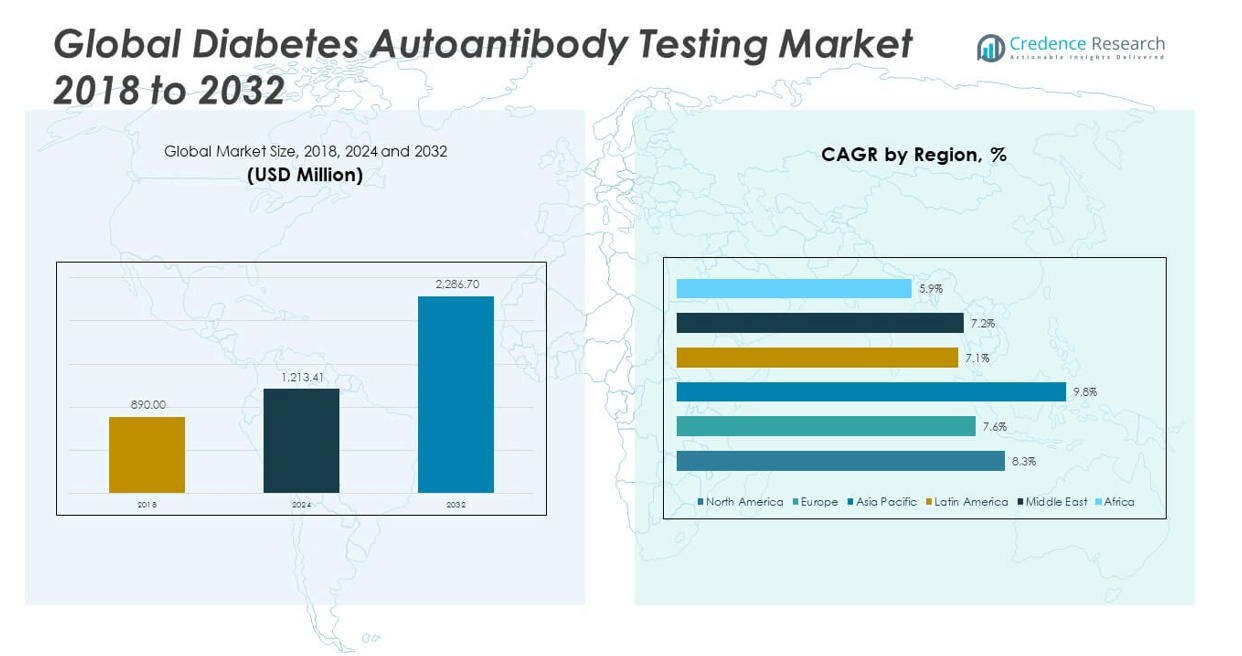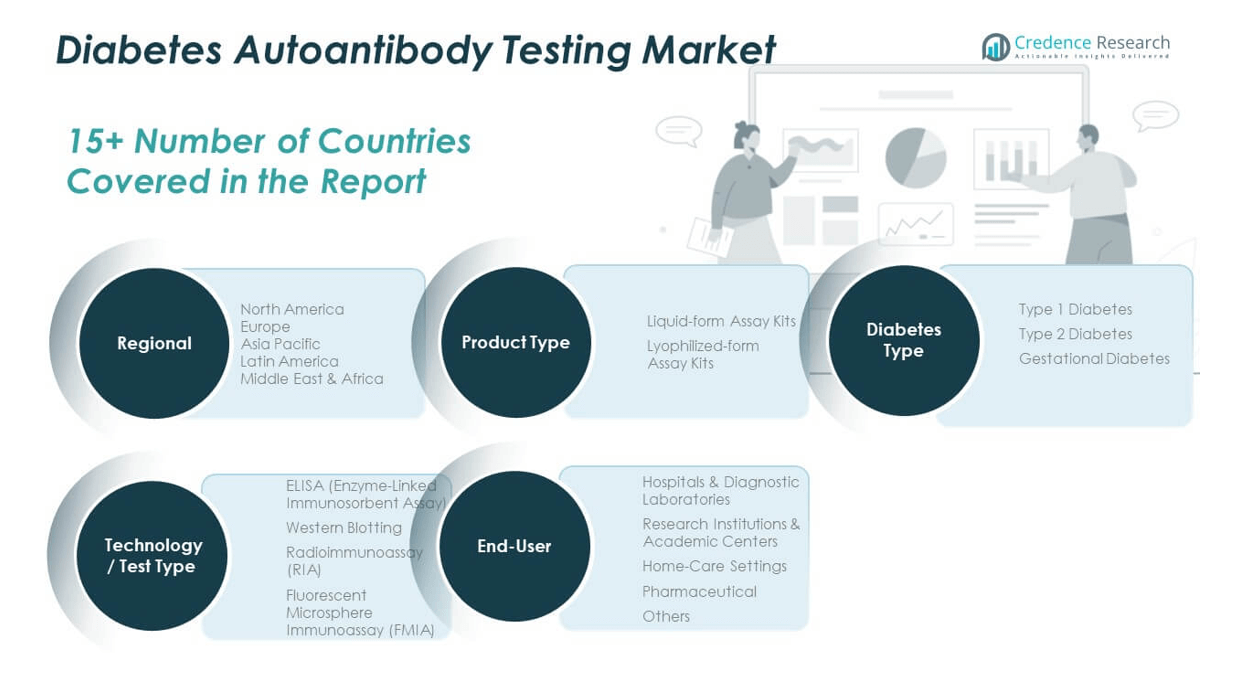CHAPTER NO. 1 : GENESIS OF THE MARKET
1.1 Market Prelude – Introduction & Scope
1.2 The Big Picture – Objectives & Vision
1.3 Strategic Edge – Unique Value Proposition
1.4 Stakeholder Compass – Key Beneficiaries
CHAPTER NO. 2 : EXECUTIVE LENS
2.1 Pulse of the Industry – Market Snapshot
2.2 Growth Arc – Revenue Projections (USD Million)
2.3. Premium Insights – Based on Primary Interviews
CHAPTER NO. 3 : DIABETES AUTOANTIBODY TESTING MARKET FORCES & INDUSTRY PULSE
3.1 Foundations of Change – Market Overview
3.2 Catalysts of Expansion – Key Market Drivers
3.2.1 Momentum Boosters – Growth Triggers
3.2.2 Innovation Fuel – Disruptive Technologies
3.3 Headwinds & Crosswinds – Market Restraints
3.3.1 Regulatory Tides – Compliance Challenges
3.3.2 Economic Frictions – Inflationary Pressures
3.4 Untapped Horizons – Growth Potential & Opportunities
3.5 Strategic Navigation – Industry Frameworks
3.5.1 Market Equilibrium – Porter’s Five Forces
3.5.2 Ecosystem Dynamics – Value Chain Analysis
3.5.3 Macro Forces – PESTEL Breakdown
3.6 Price Trend Analysis
3.6.1 Regional Price Trend
3.6.2 Price Trend by product
CHAPTER NO. 4 : KEY INVESTMENT EPICENTER
4.1 Regional Goldmines – High-Growth Geographies
4.2 Product Frontiers – Lucrative Product Categories
4.3 Diabetes Type Sweet Spots – Emerging Demand Segments
CHAPTER NO. 5: REVENUE TRAJECTORY & WEALTH MAPPING
5.1 Momentum Metrics – Forecast & Growth Curves
5.2 Regional Revenue Footprint – Market Share Insights
5.3 Segmental Wealth Flow – Product Type & Diabetes Type Revenue
CHAPTER NO. 6 : TRADE & COMMERCE ANALYSIS
6.1. Import Analysis by Region
6.1.1. Global Diabetes Autoantibody Testing Market Import Revenue By Region
6.2. Export Analysis by Region
6.2.1. Global Diabetes Autoantibody Testing Market Export Revenue By Region
CHAPTER NO. 7 : COMPETITION ANALYSIS
7.1. Company Market Share Analysis
7.1.1. Global Diabetes Autoantibody Testing Market: Company Market Share
7.2. Global Diabetes Autoantibody Testing Market Company Revenue Market Share
7.3. Strategic Developments
7.3.1. Acquisitions & Mergers
7.3.2. New Product Launch
7.3.3. Regional Expansion
7.4. Competitive Dashboard
7.5. Company Assessment Metrics, 2024
CHAPTER NO. 8 : DIABETES AUTOANTIBODY TESTING MARKET – BY PRODUCT TYPE SEGMENT ANALYSIS
8.1. Diabetes Autoantibody Testing Market Overview by Product Type Segment
8.1.1. Diabetes Autoantibody Testing Market Revenue Share By Product Type
8.2. Liquid‑form Assay Kits
8.3. Lyophilized‑form Assay Kits
CHAPTER NO. 9 : DIABETES AUTOANTIBODY TESTING MARKET – BY DIABETES TYPE SEGMENT ANALYSIS
9.1. Diabetes Autoantibody Testing Market Overview by Diabetes Type Segment
9.1.1. Diabetes Autoantibody Testing Market Revenue Share By Diabetes Type
9.2. Type 1 Diabetes
9.3. Type 2 Diabetes
9.4. Gestational Diabetes
CHAPTER NO. 10 : DIABETES AUTOANTIBODY TESTING MARKET – BY END-USER SEGMENT ANALYSIS
10.1. Diabetes Autoantibody Testing Market Overview by End-user Segment
10.1.1. Diabetes Autoantibody Testing Market Revenue Share By End-user
10.2. Hospitals & Diagnostic Laboratories
10.3. Research Institutions & Academic Centers
10.4. Home‑Care Settings
10.5. Pharmaceutical
10.6. Others
CHAPTER NO. 11 : DIABETES AUTOANTIBODY TESTING MARKET – BY TECHNOLOGY SEGMENT ANALYSIS
11.1. Diabetes Autoantibody Testing Market Overview by Distribution Channel Segment
11.1.1. Diabetes Autoantibody Testing Market Revenue Share By Distribution Channel
11.2. ELISA (Enzyme‑Linked Immunosorbent Assay)
11.3. Western Blotting
11.4. Radioimmunoassay (RIA)
11.5. Fluorescent Microsphere Immunoassay (FMIA)
CHAPTER NO. 12 : DIABETES AUTOANTIBODY TESTING MARKET – REGIONAL ANALYSIS
12.1. Diabetes Autoantibody Testing Market Overview by Region Segment
12.1.1. Global Diabetes Autoantibody Testing Market Revenue Share By Region
12.1.2. Regions
12.1.3. Global Diabetes Autoantibody Testing Market Revenue By Region
12.1.4. Product Type
12.1.5. Global Diabetes Autoantibody Testing Market Revenue By Product Type
12.1.6. Diabetes Type
12.1.7. Global Diabetes Autoantibody Testing Market Revenue By Diabetes Type
12.1.8. End-user
12.1.9. Global Diabetes Autoantibody Testing Market Revenue By End-user
12.1.10. Distribution Channel
12.1.11. Global Diabetes Autoantibody Testing Market Revenue By Distribution Channel
CHAPTER NO. 13 : NORTH AMERICA DIABETES AUTOANTIBODY TESTING MARKET – COUNTRY ANALYSIS
13.1. North America Diabetes Autoantibody Testing Market Overview by Country Segment
13.1.1. North America Diabetes Autoantibody Testing Market Revenue Share By Region
13.2. North America
13.2.1. North America Diabetes Autoantibody Testing Market Revenue By Country
13.2.2. Product Type
13.2.3. North America Diabetes Autoantibody Testing Market Revenue By Product Type
13.2.4. Diabetes Type
13.2.5. North America Diabetes Autoantibody Testing Market Revenue By Diabetes Type
13.2.6. End-user
13.2.7. North America Diabetes Autoantibody Testing Market Revenue By End-user
13.2.8. Distribution Channel
13.2.9. North America Diabetes Autoantibody Testing Market Revenue By Distribution Channel
13.3. U.S.
13.4. Canada
13.5. Mexico
CHAPTER NO. 14 : EUROPE DIABETES AUTOANTIBODY TESTING MARKET – COUNTRY ANALYSIS
14.1. Europe Diabetes Autoantibody Testing Market Overview by Country Segment
14.1.1. Europe Diabetes Autoantibody Testing Market Revenue Share By Region
14.2. Europe
14.2.1. Europe Diabetes Autoantibody Testing Market Revenue By Country
14.2.2. Product Type
14.2.3. Europe Diabetes Autoantibody Testing Market Revenue By Product Type
14.2.4. Diabetes Type
14.2.5. Europe Diabetes Autoantibody Testing Market Revenue By Diabetes Type
14.2.6. End-user
14.2.7. Europe Diabetes Autoantibody Testing Market Revenue By End-user
14.2.8. Distribution Channel
14.2.9. Europe Diabetes Autoantibody Testing Market Revenue By Distribution Channel
14.3. UK
14.4. France
14.5. Germany
14.6. Italy
14.7. Spain
14.8. Russia
14.9. Rest of Europe
CHAPTER NO. 15 : ASIA PACIFIC DIABETES AUTOANTIBODY TESTING MARKET – COUNTRY ANALYSIS
15.1. Asia Pacific Diabetes Autoantibody Testing Market Overview by Country Segment
15.1.1. Asia Pacific Diabetes Autoantibody Testing Market Revenue Share By Region
15.2. Asia Pacific
15.2.1. Asia Pacific Diabetes Autoantibody Testing Market Revenue By Country
15.2.2. Product Type
15.2.3. Asia Pacific Diabetes Autoantibody Testing Market Revenue By Product Type
15.2.4. Diabetes Type
15.2.5. Asia Pacific Diabetes Autoantibody Testing Market Revenue By Diabetes Type
15.2.6. End-user
15.2.7. Asia Pacific Diabetes Autoantibody Testing Market Revenue By End-user
15.2.8. Distribution Channel
15.2.9. Asia Pacific Diabetes Autoantibody Testing Market Revenue By Distribution Channel
15.3. China
15.4. Japan
15.5. South Korea
15.6. India
15.7. Australia
15.8. Southeast Asia
15.9. Rest of Asia Pacific
CHAPTER NO. 16 : LATIN AMERICA DIABETES AUTOANTIBODY TESTING MARKET – COUNTRY ANALYSIS
16.1. Latin America Diabetes Autoantibody Testing Market Overview by Country Segment
16.1.1. Latin America Diabetes Autoantibody Testing Market Revenue Share By Region
16.2. Latin America
16.2.1. Latin America Diabetes Autoantibody Testing Market Revenue By Country
16.2.2. Product Type
16.2.3. Latin America Diabetes Autoantibody Testing Market Revenue By Product Type
16.2.4. Diabetes Type
16.2.5. Latin America Diabetes Autoantibody Testing Market Revenue By Diabetes Type
16.2.6. End-user
16.2.7. Latin America Diabetes Autoantibody Testing Market Revenue By End-user
16.2.8. Distribution Channel
16.2.9. Latin America Diabetes Autoantibody Testing Market Revenue By Distribution Channel
16.3. Brazil
16.4. Argentina
16.5. Rest of Latin America
CHAPTER NO. 17 : MIDDLE EAST DIABETES AUTOANTIBODY TESTING MARKET – COUNTRY ANALYSIS
17.1. Middle East Diabetes Autoantibody Testing Market Overview by Country Segment
17.1.1. Middle East Diabetes Autoantibody Testing Market Revenue Share By Region
17.2. Middle East
17.2.1. Middle East Diabetes Autoantibody Testing Market Revenue By Country
17.2.2. Product Type
17.2.3. Middle East Diabetes Autoantibody Testing Market Revenue By Product Type
17.2.4. Diabetes Type
17.2.5. Middle East Diabetes Autoantibody Testing Market Revenue By Diabetes Type
17.2.6. End-user
17.2.7. Middle East Diabetes Autoantibody Testing Market Revenue By End-user
17.2.8. Distribution Channel
17.2.9. Middle East Diabetes Autoantibody Testing Market Revenue By Distribution Channel
17.3. GCC Countries
17.4. Israel
17.5. Turkey
17.6. Rest of Middle East
CHAPTER NO. 18 : AFRICA DIABETES AUTOANTIBODY TESTING MARKET – COUNTRY ANALYSIS
18.1. Africa Diabetes Autoantibody Testing Market Overview by Country Segment
18.1.1. Africa Diabetes Autoantibody Testing Market Revenue Share By Region
18.2. Africa
18.2.1. Africa Diabetes Autoantibody Testing Market Revenue By Country
18.2.2. Product Type
18.2.3. Africa Diabetes Autoantibody Testing Market Revenue By Product Type
18.2.4. Diabetes Type
18.2.5. Africa Diabetes Autoantibody Testing Market Revenue By Diabetes Type
18.2.6. End-user
18.2.7. Africa Diabetes Autoantibody Testing Market Revenue By End-user
18.2.8. Distribution Channel
18.2.9. Africa Diabetes Autoantibody Testing Market Revenue By Distribution Channel
18.3. South Africa
18.4. Egypt
18.5. Rest of Africa
CHAPTER NO. 19 : COMPANY PROFILES
19.1. Eagle Biosciences
19.1.1. Company Overview
19.1.2. Product Portfolio
19.1.3. Financial Overview
19.1.4. Recent Developments
19.1.5. Growth Strategy
19.1.6. SWOT Analysis
19.2. RSR Limed
19.3. ShenZhen Sciarray Biotechnology Co., Ltd.
19.4. Shenzhen YHLO Biotech Co., Ltd.
19.5. Shenzhen Blot Biotech Co., Ltd.
19.6. SDR (Beijing) Medical Diagnostic Products Co., Ltd.
19.7. Tianjin Aser Biotechnology Co., Ltd.
19.8. Hunan Xinchen Biotechnology Co., Ltd.
19.9. DiaSorin S.p.A.
19.10. Abbott Laboratories
19.11. Bio-Rad Laboratories, Inc.
19.12. Diazyme Laboratories, Inc.
19.13 BIOMÉRIEUX
19.14. Monobind Inc.
19.15. PTS Diagnostics
19.16. DRG Instruments GmbH
19.17. Abnova Corporation
19.18. Ortho Clinical Diagnostics
19.19. Ethos Biosciences










